An official website of the United States government
 United States Department of Labor
United States Department of Labor
Create new dance routines. Rehearse performance of routines. May direct and stage presentations.
Employment estimate and mean wage estimates for Choreographers:
| Employment (1) | Employment RSE (3) |
Mean hourly wage |
Mean annual wage (2) |
Wage RSE (3) |
|---|---|---|---|---|
| 3,580 | 11.6 % | $ 25.00 | $ 52,000 | 4.4 % |
Percentile wage estimates for Choreographers:
| Percentile | 10% | 25% | 50% (Median) |
75% | 90% |
|---|---|---|---|---|---|
| Hourly Wage | $ 10.18 | $ 14.14 | $ 21.00 | $ 30.33 | $ 48.68 |
| Annual Wage (2) | $ 21,180 | $ 29,420 | $ 43,680 | $ 63,080 | $ 101,250 |
Industries with the highest published employment and wages for Choreographers are provided. For a list of all industries with employment in Choreographers, see the Create Customized Tables function.
Industries with the highest levels of employment in Choreographers:
| Industry | Employment (1) | Percent of industry employment | Hourly mean wage | Annual mean wage (2) |
|---|---|---|---|---|
| Other Schools and Instruction | 2,160 | 0.54 | $ 23.35 | $ 48,560 |
| Performing Arts Companies | 890 | 0.87 | $ 28.46 | $ 59,200 |
| Colleges, Universities, and Professional Schools | 60 | 0.00 | $ 25.08 | $ 52,170 |
| Elementary and Secondary Schools | 50 | 0.00 | $ 17.45 | $ 36,300 |
| Independent Artists, Writers, and Performers | 40 | 0.09 | $ 20.71 | $ 43,070 |
Industries with the highest concentration of employment in Choreographers:
| Industry | Employment (1) | Percent of industry employment | Hourly mean wage | Annual mean wage (2) |
|---|---|---|---|---|
| Performing Arts Companies | 890 | 0.87 | $ 28.46 | $ 59,200 |
| Other Schools and Instruction | 2,160 | 0.54 | $ 23.35 | $ 48,560 |
| Independent Artists, Writers, and Performers | 40 | 0.09 | $ 20.71 | $ 43,070 |
| Elementary and Secondary Schools | 50 | 0.00 | $ 17.45 | $ 36,300 |
| Colleges, Universities, and Professional Schools | 60 | 0.00 | $ 25.08 | $ 52,170 |
Top paying industries for Choreographers:
| Industry | Employment (1) | Percent of industry employment | Hourly mean wage | Annual mean wage (2) |
|---|---|---|---|---|
| Performing Arts Companies | 890 | 0.87 | $ 28.46 | $ 59,200 |
| Colleges, Universities, and Professional Schools | 60 | (7) | $ 25.08 | $ 52,170 |
| Other Schools and Instruction | 2,160 | 0.54 | $ 23.35 | $ 48,560 |
| Independent Artists, Writers, and Performers | 40 | 0.09 | $ 20.71 | $ 43,070 |
| Other Amusement and Recreation Industries | (8) | (8) | $ 18.00 | $ 37,430 |
States and areas with the highest published employment, location quotients, and wages for Choreographers are provided. For a list of all areas with employment in Choreographers, see the Create Customized Tables function.
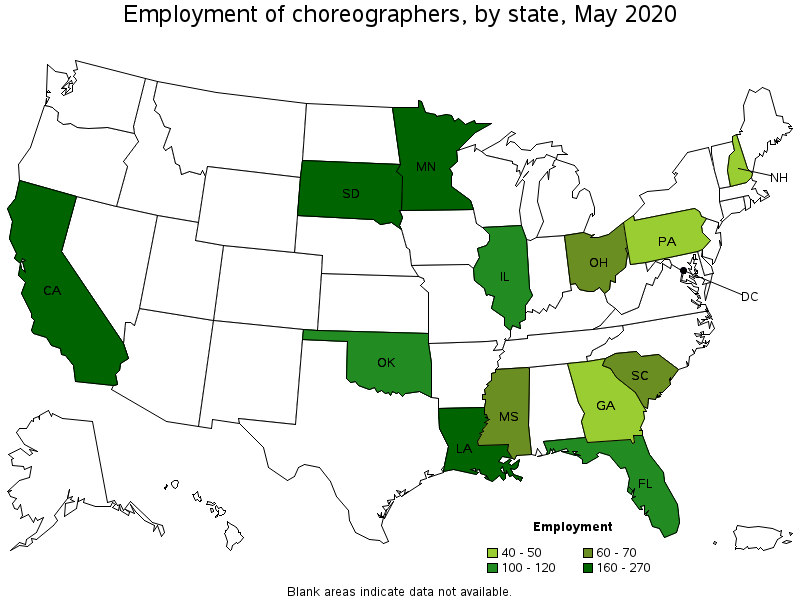
States with the highest employment level in Choreographers:
| State | Employment (1) | Employment per thousand jobs | Location quotient (9) | Hourly mean wage | Annual mean wage (2) |
|---|---|---|---|---|---|
| Louisiana | 270 | 0.15 | 5.90 | $ 24.59 | $ 51,140 |
| Minnesota | 240 | 0.09 | 3.48 | $ 22.73 | $ 47,290 |
| California | 210 | 0.01 | 0.49 | $ 35.00 | $ 72,800 |
| South Dakota | 160 | 0.39 | 15.33 | $ 15.61 | $ 32,480 |
| Oklahoma | 120 | 0.08 | 2.98 | (8) | (8) |
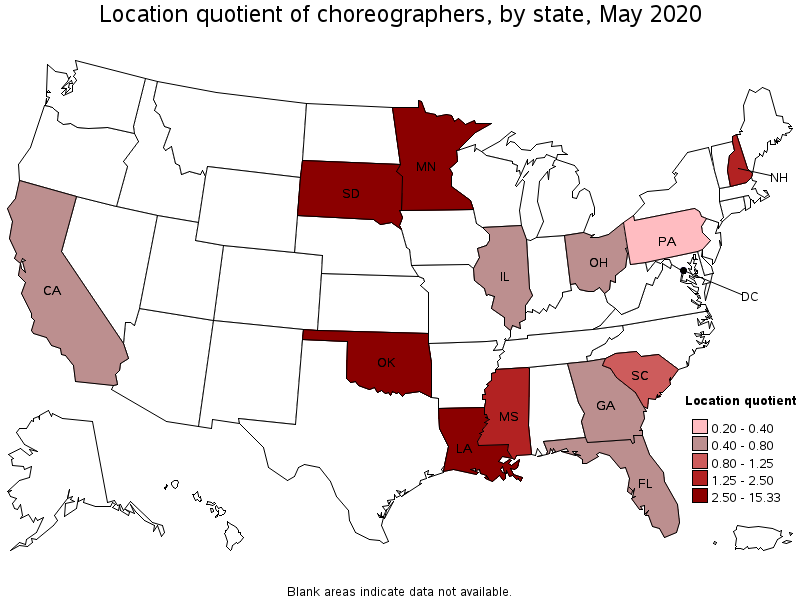
States with the highest concentration of jobs and location quotients in Choreographers:
| State | Employment (1) | Employment per thousand jobs | Location quotient (9) | Hourly mean wage | Annual mean wage (2) |
|---|---|---|---|---|---|
| South Dakota | 160 | 0.39 | 15.33 | $ 15.61 | $ 32,480 |
| Louisiana | 270 | 0.15 | 5.90 | $ 24.59 | $ 51,140 |
| Minnesota | 240 | 0.09 | 3.48 | $ 22.73 | $ 47,290 |
| District of Columbia | 60 | 0.08 | 3.20 | $ 45.67 | $ 95,000 |
| Oklahoma | 120 | 0.08 | 2.98 | (8) | (8) |
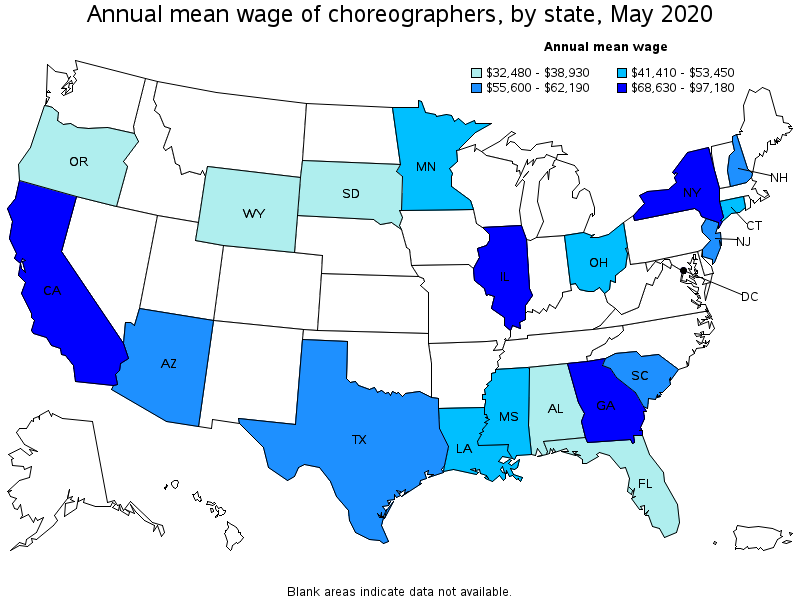
Top paying states for Choreographers:
| State | Employment (1) | Employment per thousand jobs | Location quotient (9) | Hourly mean wage | Annual mean wage (2) |
|---|---|---|---|---|---|
| New York | (8) | (8) | (8) | $ 46.72 | $ 97,180 |
| District of Columbia | 60 | 0.08 | 3.20 | $ 45.67 | $ 95,000 |
| California | 210 | 0.01 | 0.49 | $ 35.00 | $ 72,800 |
| Georgia | 50 | 0.01 | 0.45 | $ 33.58 | $ 69,850 |
| Illinois | 100 | 0.02 | 0.68 | $ 33.00 | $ 68,630 |
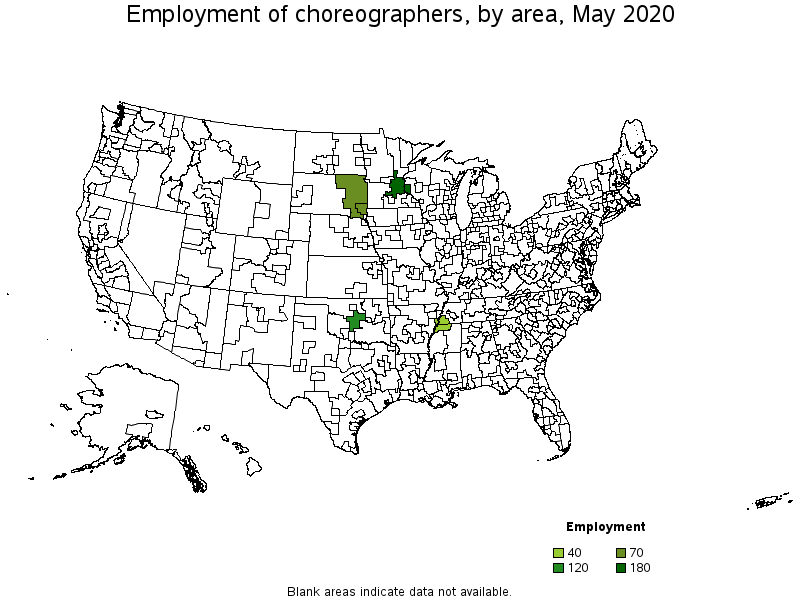
Metropolitan areas with the highest employment level in Choreographers:
| Metropolitan area | Employment (1) | Employment per thousand jobs | Location quotient (9) | Hourly mean wage | Annual mean wage (2) |
|---|---|---|---|---|---|
| Minneapolis-St. Paul-Bloomington, MN-WI | 180 | 0.10 | 3.72 | $ 25.49 | $ 53,030 |
| Oklahoma City, OK | 120 | 0.19 | 7.57 | (8) | (8) |
| Sioux Falls, SD | 70 | 0.44 | 17.01 | $ 18.88 | $ 39,270 |
| Memphis, TN-MS-AR | 40 | 0.06 | 2.25 | $ 27.95 | $ 58,140 |
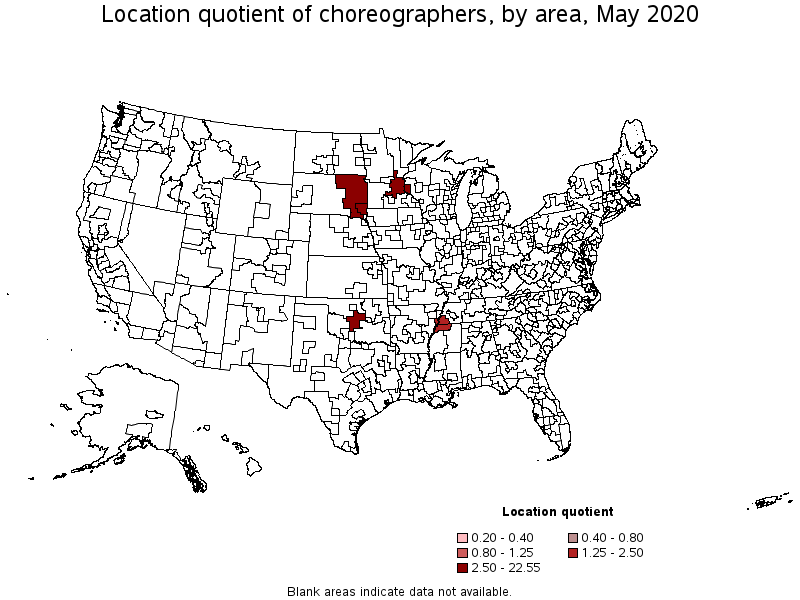
Metropolitan areas with the highest concentration of jobs and location quotients in Choreographers:
| Metropolitan area | Employment (1) | Employment per thousand jobs | Location quotient (9) | Hourly mean wage | Annual mean wage (2) |
|---|---|---|---|---|---|
| Sioux Falls, SD | 70 | 0.44 | 17.01 | $ 18.88 | $ 39,270 |
| Oklahoma City, OK | 120 | 0.19 | 7.57 | (8) | (8) |
| Minneapolis-St. Paul-Bloomington, MN-WI | 180 | 0.10 | 3.72 | $ 25.49 | $ 53,030 |
| Memphis, TN-MS-AR | 40 | 0.06 | 2.25 | $ 27.95 | $ 58,140 |
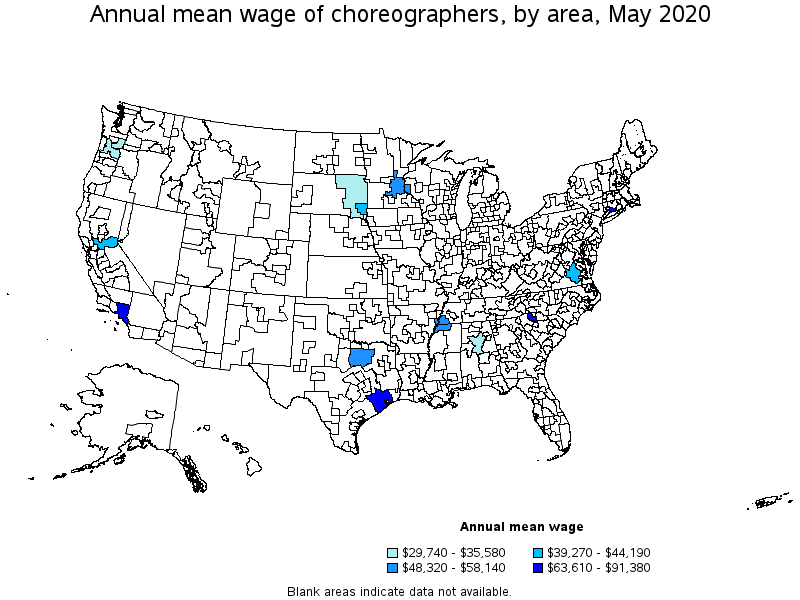
Top paying metropolitan areas for Choreographers:
| Metropolitan area | Employment (1) | Employment per thousand jobs | Location quotient (9) | Hourly mean wage | Annual mean wage (2) |
|---|---|---|---|---|---|
| Los Angeles-Long Beach-Anaheim, CA | (8) | (8) | (8) | $ 43.93 | $ 91,380 |
| Spartanburg, SC | (8) | (8) | (8) | $ 34.11 | $ 70,940 |
| New Haven, CT | (8) | (8) | (8) | $ 32.76 | $ 68,140 |
| Houston-The Woodlands-Sugar Land, TX | (8) | (8) | (8) | $ 30.58 | $ 63,610 |
| Memphis, TN-MS-AR | 40 | 0.06 | 2.25 | $ 27.95 | $ 58,140 |
| Minneapolis-St. Paul-Bloomington, MN-WI | 180 | 0.10 | 3.72 | $ 25.49 | $ 53,030 |
| Dallas-Fort Worth-Arlington, TX | (8) | (8) | (8) | $ 23.23 | $ 48,320 |
| Sacramento--Roseville--Arden-Arcade, CA | (8) | (8) | (8) | $ 21.24 | $ 44,190 |
| Richmond, VA | (8) | (8) | (8) | $ 19.18 | $ 39,900 |
| Sioux Falls, SD | 70 | 0.44 | 17.01 | $ 18.88 | $ 39,270 |
Nonmetropolitan areas with the highest employment in Choreographers:
| Nonmetropolitan area | Employment (1) | Employment per thousand jobs | Location quotient (9) | Hourly mean wage | Annual mean wage (2) |
|---|---|---|---|---|---|
| East South Dakota nonmetropolitan area | 70 | 0.58 | 22.55 | $ 14.30 | $ 29,740 |
Nonmetropolitan areas with the highest concentration of jobs and location quotients in Choreographers:
| Nonmetropolitan area | Employment (1) | Employment per thousand jobs | Location quotient (9) | Hourly mean wage | Annual mean wage (2) |
|---|---|---|---|---|---|
| East South Dakota nonmetropolitan area | 70 | 0.58 | 22.55 | $ 14.30 | $ 29,740 |
Top paying nonmetropolitan areas for Choreographers:
| Nonmetropolitan area | Employment (1) | Employment per thousand jobs | Location quotient (9) | Hourly mean wage | Annual mean wage (2) |
|---|---|---|---|---|---|
| East South Dakota nonmetropolitan area | 70 | 0.58 | 22.55 | $ 14.30 | $ 29,740 |
These estimates are calculated with data collected from employers in all industry sectors, all metropolitan and nonmetropolitan areas, and all states and the District of Columbia. The top employment and wage figures are provided above. The complete list is available in the downloadable XLS files.
The percentile wage estimate is the value of a wage below which a certain percent of workers fall. The median wage is the 50th percentile wage estimate—50 percent of workers earn less than the median and 50 percent of workers earn more than the median. More about percentile wages.
(1) Estimates for detailed occupations do not sum to the totals because the totals include occupations not shown separately. Estimates do not include self-employed workers.
(2) Annual wages have been calculated by multiplying the hourly mean wage by a "year-round, full-time" hours figure of 2,080 hours; for those occupations where there is not an hourly wage published, the annual wage has been directly calculated from the reported survey data.
(3) The relative standard error (RSE) is a measure of the reliability of a survey statistic. The smaller the relative standard error, the more precise the estimate.
(7) The value is less than .005 percent of industry employment.
(8) Estimate not released.
(9) The location quotient is the ratio of the area concentration of occupational employment to the national average concentration. A location quotient greater than one indicates the occupation has a higher share of employment than average, and a location quotient less than one indicates the occupation is less prevalent in the area than average.
Other OEWS estimates and related information:
May 2020 National Occupational Employment and Wage Estimates
May 2020 State Occupational Employment and Wage Estimates
May 2020 Metropolitan and Nonmetropolitan Area Occupational Employment and Wage Estimates
May 2020 National Industry-Specific Occupational Employment and Wage Estimates
Last Modified Date: March 31, 2021